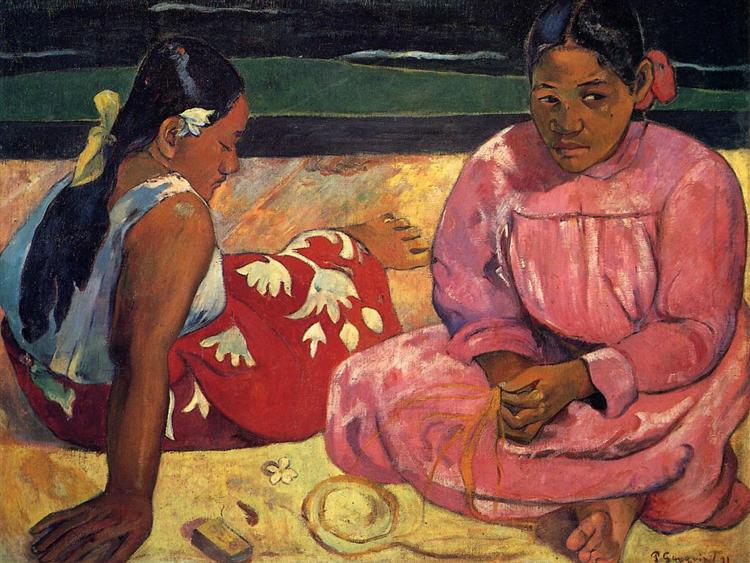Description
Paul Gauguin's painting "Tahitian Women", created in 1891, is a work that encapsulates the essence of symbolism and the search for a primitive reality through a perfectly crafted visual language. This piece reveals the way Gauguin stripped away European conventions to immerse himself in Tahitian culture, a world he found attractive not only for its natural beauty, but also for the richness of its traditions and ways of life.
In the foreground of the work, two Tahitian women can be seen, depicted in a stylized manner and with a vibrant color palette. The composition is notable for its use of plane and contrast. The figures, with their characteristic expressions and postures, seem to symbolize a deep connection with nature and their surroundings. The standing woman on the left is adorned with a bright red sarong, while the seated woman on the right is dressed in softer tones and is framed by lush vegetation that seems to give her an organic identity.
Gauguin uses bold colouring that not only respects the light and tropical life of Tahiti, but also acts as a vehicle for emotion and feeling. The green and yellow hues contrast with the reds and browns of the dresses, creating an atmosphere of vibrant vitality. The colours are not merely descriptive; they suggest an emotionality that tends to sublimate the visual experience into a transcendent reality. The background, with its detailed representation of leaves and flowers, seems to visually unite with the figures, suggesting that humans and nature are intrinsically connected.
The use of line is central to this work. The contours of the figures are soft and curvilinear, giving a sense of fluidity and movement. Throughout art history, this tendency towards stylization and simplification of forms is associated with naive art and symbolism, styles that Gauguin adopted and adapted to his own vision. This work, in particular, demonstrates Gauguin's interest in distancing himself from realism in favor of a more spiritual and emotional representation, a quest that can also be seen in his later works.
An interesting aspect about “Tahitian Women” is the historical context in which it was created. Gauguin traveled to Tahiti in search of a more primitive and pure life, far from the industrialization of Europe. The women in his work are depicted not just as individuals, but as representatives of a lifestyle that he considered more authentic and connected to the land. However, this romantic ideal often clashed with the reality of Tahitian culture, and has been the subject of debates surrounding the representation of colonial subjects in art.
Tahitian Women is a work that, while singular, is part of a larger body of work that Gauguin produced during his time on the island. Paintings such as Where Do We Come From? What Are We? Where Are We Going? and The Vision After the Sermon also explore themes of identity, spirituality, and the human condition through a highly distinctive style. Through this work, the viewer not only witnesses a moment of life in Tahiti, but is also confronted with the story of an artist resolutely committed to exploring the deeper meaning of being human in a changing world.
In short, Tahitian Women is a reflection on the contrasts between the search for authenticity and the complexity of human experience, encapsulating both Gauguin's fascination with Tahitian culture and his contribution to symbolism and modern art. This work invites us to consider the intersection of culture, color, form and emotion, elements that have defined and will continue to define Paul Gauguin's legacy in the Western art landscape.
KUADROS ©, a famous painting on your wall.
Hand-made oil painting reproductions, with the quality of professional artists and the distinctive seal of KUADROS ©.
Painting reproduction service with satisfaction guarantee. If you are not completely satisfied with the replica of your painting, we will refund 100% of your money.

